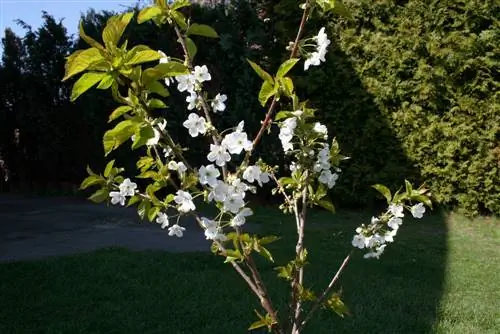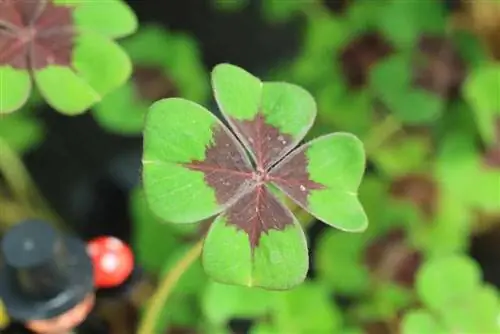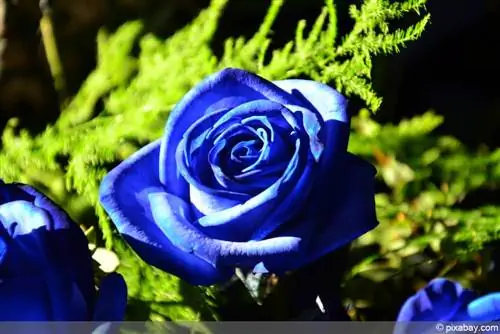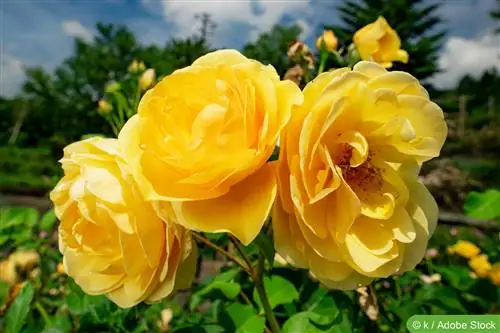- Author admin [email protected].
- Public 2023-12-17 03:39.
- Last modified 2025-06-01 06:48.
When the 4th of December marks the anniversary of Saint Barbara's name day, there is a lot of activity in the fields, forests and gardens. Crowds of custom followers are out and about cutting branches from fruit trees or forsythia bushes and placing them in water. On this day of remembrance, a traditional custom is celebrated, culminating in the cut Barbara branches being in full bloom on Christmas Eve. The popular ritual is associated with a we alth of secular and religious meanings. Read all the information about St. Barbara's Day here with tips and tricks on how to make a St. Barbara's branch bloom.
Cutting Barbara branch - instructions for the process on Barbara Day
Although there are numerous legends and myths surrounding St. Barbara's Day, the actual process of the custom is based on a firmly cemented protocol that has been handed down since the Middle Ages. The deadline every year is December 4th, the liturgical memorial day of Saint Barbara. On this day, cut branches from spring-flowering trees and place them in water so that they are in full bloom by Christmas time. All questions about the specific procedure will receive a well-founded answer below.
Which types of wood are suitable?
Barbara branches are traditionally cut from cherry trees. The branches of other fruit trees, such as apple, plum, hazelnut, elderberry, almond and horse chestnut, also come into consideration. The classics for pruning on St. Barbara's Day also include forsythia and broom. Japanese quince, cornelian cherry or other immigrated flowering trees serve as modern versions to take Barbara branches from.
What time of day do you edit?
Custom dictates that a Barbara branch only bears flowers if it is cut under special conditions on December 4th. A branch that you cut before sunrise has the best conditions. If you miss this time, grab the scissors during the vesper bells when the church bells call for evening prayer.
What should you pay attention to when cutting?
Select a he althy branch that shows no signs of disease or pest infestation. Furthermore, it should have as many buds as possible. These can be recognized as slight bumps under the bark. If you run your finger over the branch, you can feel the sleeping eyes. Please use freshly sharpened scissors whose blades have been disinfected with alcohol. Unclean cutting tools and frayed cuts put the tree at risk of being infected by pathogens when cutting Barbara branches.
Tip:
The buds on fruit trees are equipped with a natural inhibition so that they do not sprout prematurely. In order for a Barbara branch to bloom, it should have experienced a night below freezing shortly before December 4th. If a Barbara branch did not receive any cold stimulus before cutting, place it in the freezer compartment of the refrigerator for 6 to 12 hours.
Putting a barbara branch in water - how to do it correctly?
Hold the fresh, he althy branch in your hands and cut it diagonally at the end of the shoot. In this way, the conductive pathways are exposed over a larger area than after a straight cut. Water and nutrients can be transported better in this way. Please do not tap the end of the branch with a hammer, as is sometimes erroneously practiced in customs. It has been proven that the damage to the tissue promotes the premature formation of rot and destroys the hopes of a Christmas blossom splendor in advance. Proceed as follows:
- Pour lukewarm water into a clean vase
- Set the Barbara branch upright
- To sprout, place in a slightly temperate room until buds swell
- Then place in a bright, warm location
- Change the water and clean the vase every 3 days
Avoid a location in close proximity to an active radiator or oven. To prevent the buds from drying out under the influence of dry heating air, spray the branch with lime-free, lukewarm water every 2 days. If the interface at the end of the branch turns brown, trim a little more so that the supply channels are not blocked. Experience has shown that with this care program, blooming Barbara branches last until Epiphany.

In this sequence, a shortened transition from winter to spring is simulated, whereupon the inhibitors in the flowering branch are broken down. Since a Barbara branch now believes it is in spring, it allows its buds to swell and bloom.
Tip:
There are numerous farm rules for Barbara's Day, such as: If Barbara goes in the clover, the Christ child comes in the snow. Saint Barbara in the snow, bring lots of clover next year.
Custom based on the Barbara legend
The tradition of the Barbara branches has been celebrated since the Middle Ages in memory of Saint Barbara. Revered as the patroness of the dying, she is one of the 14 Helpers in Need, a group of popular saints in the Catholic faith.
Legend says that Barbara was born in Nicomedia as the daughter of a pagan and very we althy Turk. She was so beautiful that Dioscurus locked his daughter in a tower when he traveled. This measure was intended to ensure her safety, preserve her chastity and prevent inappropriate marriage. By incarcerating her, however, her father was unable to prevent his daughter from converting to Christianity. Barbara was not only beautiful, but also had a sharp mind. She corresponded with the well-known theologian Origen, who transmitted his answers through the priest Valentinus. He was also the one who baptized Barbara. As a visible sign of her new belief in the Trinity, she had a third window built into the tower.
When her father returned and noticed the extra window, he confronted Barbara and was horrified by her conversion and baptism. In the period that followed, he made numerous attempts to dissuade his daughter from her Christian faith. However, he had to realize that Barbara did not back down from her profession of faith. Ultimately, the enraged Dioscurus handed his daughter over to persecution of Christians in 306. Barbara fled and hid in a crevice. Here she was discovered by a shepherd who revealed her whereabouts to the captors who captured her. The shepherd was transformed by God into a dung beetle as punishment for his betrayal. Other traditions report that the shepherd was turned to stone and his sheep into locusts.
On her father's orders, Barbara was sent to prison to renounce her Christian faith under torture. On the way to the dungeon, a cherry branch got caught in her clothes. In her cell, Barbara placed this branch in a jug of water. On the day of her martyrdom the buds opened, even though it was the middle of winter. Barbara is then said to have exclaimed: You appeared as if you were dead. Now you have blossomed into a more beautiful life. This is what will happen to me in death. I will blossom into a better life forever.
Then the legend goes on to say that Jesus Christ appeared to Barbara and received a promise from him. This says that no Christian who calls on her as his intercessor before God dies suddenly without first receiving the holy sacraments. Therefore, she was accepted into the community of 14 helpers as patroness of the dying.
Dioscurus showed no mercy and is said to have ultimately beheaded his daughter with his own hands. The punishment for this crime followed immediately when he was struck dead by lightning.
Barbara branch as an oracle - meaning between faith and superstition
The customs on St. Barbara's Day were already mentioned in writing in the early Middle Ages. Since then, the cutting of St. Barbara's branches has developed into an oracle custom that is associated with a variety of meanings, depending on regional folk beliefs. The following overview presents the most common interpretations in more detail:
Harvest Oracle
In earlier times, farmers made a direct connection between the number of flowers and the harvest yield in the coming year. A richly blooming Barbara branch made the entire farming family confident that a rich harvest would be harvested next year. However, if only a few buds develop into flowers, this portends bad premonitions for a meager harvest.
Fertility Oracle
Another meaning also comes from the agricultural sector. When farmers drove the last cattle from the pasture to the stable before the onset of winter, they collected a few Barbara branches along the way. Placed in the warm room, they counted the number of flowers at Christmas time to determine how many calves they would have the next year.
Love Oracle
If young girls wanted to know whether their secret love would come true, a Barbara branch served as a medium. The name of the worshiped person was carved into the bark and the branch was placed in water. Blossoming buds by Christmas meant that their love would be reciprocated and a wedding would soon take place.
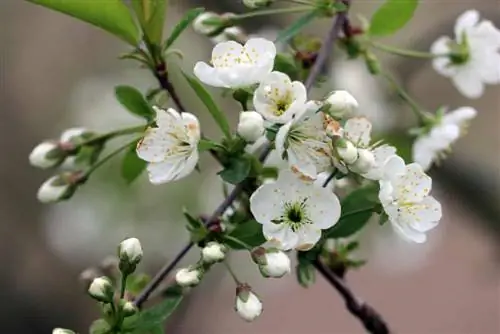
Marriage Oracle
In Bavaria and Austria, Barbara branches traditionally act as oracles as to whether marriageable virgins will be married next year. If several admirers are waiting, each branch is given a name tag and placed in the vase. Whoever's branch bears the most flowers is considered the most promising candidate for an engagement or marriage.
Lucky Oracle
In various regions of Germany and Austria, families put a whole bouquet of St. Barbara's branches in the vase on St. Barbara's Day. Each branch has the name tag of a family member. The branches will be watched like a hawk until Christmas. Whoever's branch blooms first will be the lucky child of the family next year.
Lotto Oracle
Since blooming Barbara branches are always considered a good luck charm, lottery players use the custom to predict the winning numbers. If you take it very seriously, put 49 branches in the water on St. Barbara's Day, marked with number cards. The first 6 flower branches represent next year's winning numbers.
Sacral Meaning
Beyond all superstition, the blossomed branches symbolize Jesus Christ, the sprout from the root of Jesse. Just as a bud on St. Barbara's branch bursts its tight covering, so the believer is awakened to new life through the birth of the Savior.
Special shape Barbara tree
For a long time it was customary to cut not only individual branches but also complete leading branches with numerous side branches on St. Barbara's Day. They were placed in the living room like small trees so that they would bloom at Christmas. It was also traditional to decorate a St. Barbara tree at Christmas with apples, candy or gold-plated nuts. When this custom became widespread and caused considerable damage to fruit cultivation as a result of these lootings, it was stopped in the 18th century. Banned in most regions by the Margrave in the 19th century. Since the poor rural population did not use valuable fruit trees, but rather spruce and fir trees, the Barbara tree is now considered by some historians to be the forerunner of the Christmas tree.
Conclusion
On December 4th, a traditional custom that has been forgotten for a long time is celebrated. On this day, Christians celebrate the memorial of Saint Barbara, a 4th century martyr who is one of the 14 helpers. Before sunrise or during vespers, the branches of spring-flowering trees are cut off and placed in lukewarm water. Every Barbara branch is accompanied with the hope that it will bloom for Christmas. Friends of the custom derive numerous secular and religious meanings from the number of its flowers, the most common of which you can read about here. If you want to slow down your fast-paced everyday life with flowering branches at Christmas time, you shouldn't miss St. Barbara's Day to cut a St. Barbara's branch according to the old fashion and these instructions.

